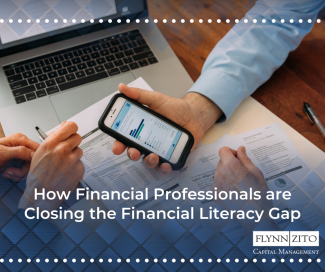
How Financial Professionals are Closing the Financial Literacy Gap
The financial literacy gap—or the gaps in financial knowledge among various sectors of the public—may have racial, gender, and socioeconomic components. Those whose parents or mentors are experienced investors who may provide sage advice have a leg up on those who must navigate the process themselves.
However, financial professionals have identified ways to close these gaps and make budgeting, investing, and wealth creation more accessible to more people. Below, we discuss a few ways financial professionals are starting to bridge the financial literacy gap.
Identifying Root Causes of the Financial Literacy Gap
To begin to fix gaps in financial knowledge, it's important to understand more about their origins. Some may have a socioeconomic or educational basis. Those whose parents and other close family members never attended college may not have the base of knowledge they need to evaluate student loans, for example.
Other gaps may be based on gender. The Equal Credit Opportunity Act of 1974 allowed women to enjoy the same access to credit as men. Those whose parents entered the workforce or were married before this law was passed may not be able to provide much insight into credit cards, credit scores, or debt repayment if they lack much experience with credit themselves.1
Meanwhile, children of parents born outside the U.S. may be at a disadvantage when navigating America's specialized and sometimes confusing credit regulations—from knowing what factors go into a credit score to what steps are necessary to follow to purchase a home.
Because financial knowledge builds upon itself, families lacking that generational experience may feel left out.
Making Financial Literacy More Accessible and Relatable
One of the key things that financial professionals may be able to do—and are doing—to close the financial literacy gap involves breaking down complex topics into easy-to-digest pieces that prompt further research. For example, publishing a blog to explain what goes into a credit score may encourage readers to check their own scores and see what changes they may be able to make to potentially improve them. Recording a podcast where you interview a real estate agent and bank loan officer may give listeners insight into what they need to do to make the home purchasing process go more smoothly.
By making this information accessible and relating it to dilemmas and decisions that many Americans are facing—finding and purchasing health insurance, moving to a new job, purchasing a home, paying down student loans, or saving for retirement—financial professionals may expand their reach while helping build a strong base of knowledge.
Combating Misinformation
While today's consumers have access to more information than the generations before them, not all of this information is good or accurate. It's important for financial professionals to use their credentials and influence to fight back against financial misinformation when they come across it. A post or article may be reported as inaccurate and potentially removed depending on the platform. However, it may be more effective in some cases to explain exactly what is wrong and why.
Financial professionals have an important role in improving financial literacy, and many are taking advantage of their position to work to close the financial literacy gap.
Important Disclosures
The opinions voiced in this material are for general information only and are not intended to provide specific advice or recommendations for any individual.
All information is believed to be from reliable sources; however LPL Financial makes no representation as to its completeness or accuracy.
This article was prepared by WriterAccess.
LPL Tracking #1-05241767
